IMPACT: WHAT LIES BENEATH?
Supporting outstanding science in Australia’s universities


Supporting outstanding science in Australia’s universities

Australia is home to some of the world’s best universities. The scientific research and teaching that takes place at these universities can change the world and make all of our lives better.
It can lead to new products, jobs and industries that we couldn’t even have imagined in the early days of the research cycle.
I know this firsthand. Work in my own area of astro-particle physics has underpinned features of our daily lives like Wi-Fi, digital cameras, GPS, the internet and even iPhone touch screens — world-changing by-products of our quest to understand the universe.
But we need to make sure our universities can continue to deliver on this promise for future generations.
It’s important to think about how we fund and translate scientific research in Australia today, so that basic curiosity-driven science can continue to change the world in ways we can’t yet imagine.
We have to create an environment where there is enough stability that our brilliant young scientists can focus on their work, without being constantly stressed about career progression.
Science is constantly moving forward
not because of a handful of brilliant individuals, but because we step forward together. That’s the beauty of science — people sharing ideas and discoveries so they can be built upon.
We need to focus on how we treat young researchers, and how we bring women and a whole diverse range of people from non-traditional backgrounds into science specifically — and also into academia in general.
I was lucky enough to be part of a Nobel Prize-winning discovery and if we want more of these at Australian institutions, we need to support our young researchers, and provide them with career structures that offer some certainty.
I’m about to make a big change, heading back to my first love: scientific research and teaching. It will be very different to my time spent running a university. But my love for the university environment is undimmed.
I can’t wait to see what the next chapter in Australian science brings.
Professor Brian P. Schmidt AC FAA FRS Vice-Chancellor & President, The Australian National UniversityExploring the achievements of university science in building Australia’s sovereign capability
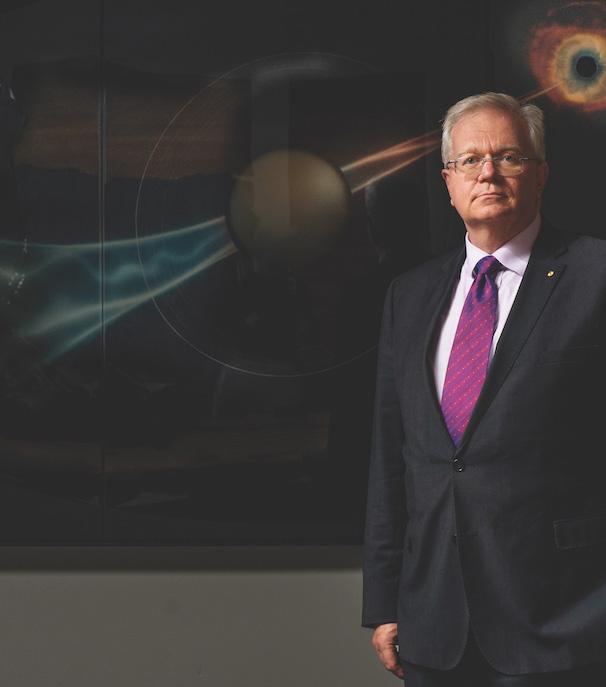
Australia’s strong science research and training is integral to driving new economies. Universities have a critical role as partners in establishing innovation and technological change in industry. As science delivers new insights and tools, new industries are emerging, and people with science skills will be essential to these new industries. Australian University Science magazine highlights these stories, showcasing exceptional science teams and Australian science graduates working in industry. To provide feedback or suggestions, subscribe or order additional copies, visit acds.edu.au/AustUniScience
Cover Image: Professor Xiaojing Hao holding the highly efficient solar cells developed at UNSW. Image: UNSW. Published 13 September 2023 by Refraction Media on behalf of the Australian Council of Deans of Science. Designed by Jon Wolfgang Miller. Printed in Australia by IVE. ISSN: 2652-2403.
© 2023 Australian Council of Deans of Science, all rights reserved. No part of this publication may be reproduced in any manner or form without written permission. If you would like to reproduce anything from this issue, email info@refractionmedia.com.au.
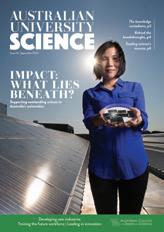
University science supports a living ecosystem of knowledge.
Look up from this article and fasten your eyes on something in the room, or out your window. Undoubtedly, you’ll see something that science contributed to or can explain, such as the health of your body or the technology you’re using. Why the sky is blue, how the vastness of geologic time created the landscape out your window, the chemistry that underpins the molecular makeup of the items in your room — science is behind all the answers.
The vast majority of basic and strategic science is carried out within universities. And it draws on hundreds of years of discovery, shared knowledge, and an atmosphere of learning. This is what underpins university science. In Australia, most basic research is undertaken in universities, says the University of Queensland’s Provost and Senior Vice-President, Professor Aidan Byrne.
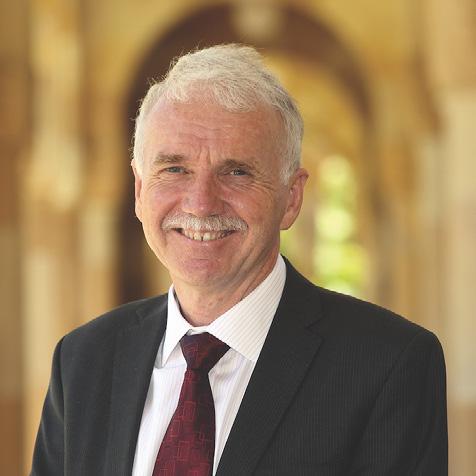

“This is unique globally,” Byrne says. “The poster child for Australian science research at the moment is quantum science. Unlike with optical and radioastronomy, which developed thanks to our Southern Hemisphere location and dark sky, there is no reason for Australia to lead in quantum science. It happened thanks to decades of investment in higher education research.”
“Science is fundamental to society. What scientists do, firstly, is education of students at the undergraduate, graduate and postgraduate levels,” says Frank Larkins, Professor Emeritus in the School of Chemistry at the University of Melbourne. “The scaffold of research, the foundations, are what science and related faculties establish. Medical sciences and engineering build on the fundamental scientific breakthroughs from chemistry, physics and mathematics, supported by the biosciences and computer science.”
Creating a great environment for research — and knowledge sharing — plus mechanisms that ensure good people can draw on that knowledge to the benefit of society is university science’s challenge.
“A successful science faculty at an Australian university has to think about the pathways to different degrees and professions. It doesn’t mean graduates don’t become scientists, they do — but not everyone will do a science PhD,” says Professor Margaret Sheil AO, Vice-Chancellor and president of QUT. However the skills of science graduates benefit society as a whole, she adds.
Universities have a capacity that no other organisation has, adds Larkin. “A university does applied research but has a much greater breadth. And the fundamental product is quality people.”
Edwina Cornish AO, former Monash Deputy Vice-Chancellor Research, Provost and Senior Vice-President, says “You recruit good people, and they know what’s needed to keep the best researchers at the bleeding edge.” Then it’s a case of finding ways to “turbo charge” early-career researchers, Cornish adds, particularly in areas where there is an opportunity to be globally competitive.

Bringing everyone together helps, Larkin says. “You walk across the campus and run into someone from engineering, medical, or another science and ask, ‘What are you working on?’, and sometimes that stimulates an idea for further fundamental research. The rich interactive dynamic that occurs, if it is nurtured properly, is a university’s greatest strength.” —
Heather Catchpole“UNLIKE IN RADIOASTRONOMY, THERE IS NO REASON FOR AUSTRALIA TO LEAD IN QUANTUM SCIENCE. IT HAPPENED THANKS TO DECADES OF INVESTMENT IN HIGHER EDUCATION RESEARCH.”Margaret Sheil
and other universities has led to Australia creating the most commercially viable solar cells for electricity infrastructure.
Australia’s universities have built the nation’s quantum expertise and abilities for decades, making a multibillion-dollar industry possible.
An industry estimated to be worth $2.2 billion by 2030, and $6 billion by 2045. Up to 19,400 new jobs. That’s what Industry and Science Minister Ed Husic says quantum technologies offer Australia. “I can’t emphasise this enough, quantum technologies will be truly transformative,” he says.
Australian quantum capability has been many decades in the making, with a foundation possible only through the university ecosystem.
Professor Hans Bachor is regarded as a pioneer of quantum optics in Australia. The field barely existed when Bachor arrived at Australian National University (ANU) as a postdoctoral scientist in 1981. “With a small team of researchers, I started exploring photonics — the quantum nature of light,” he recalls.
Improvements in the early days were incremental, and funded largely by the university.
basically ticking off, bit by bit, a long list of [requirements] that needed to
be met before you could call a machine a quantum sensor, computer or encryptor,” he says. “Critically, the research community also built necessary fabrication facilities and clean rooms on site, and custom-made equipment was possible thanks to personal ties with colleagues in the USA and Germany.”

Other universities were building quantum science capability in the late 1980s and early 1990s, too. At the University of Queensland, Professor Halina Rubinsztein-Dunlop built coldatom capability, and Professor Robert Clark established research teams and infrastructure such as the National Pulsed Magnetic Laboratory at the University of New South Wales (UNSW). This capability was later absorbed into the Special Research Centre for Quantum Computer Technology, which became the ARC Centre of Excellence for Quantum Computer Technology (CQCT).
Throughout this time, dozens of graduate students and post-doctoral researchers were being trained in the emerging avenues of research. Along with this growing expertise, new collaborations were formed, and the huge potential of the research drew further investment and exploration amongst university science.
In 2003, Bachor was appointed founding director of the ARC Centre of Excellence for QuantumAtom Optics (ACQAO), established to study atoms and light at the quantum level and to explore options for future quantum technologies.
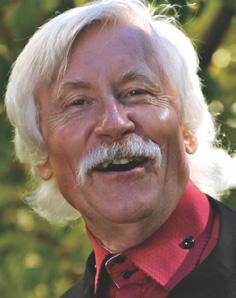
Partner institutions were ANU, Swinburne University of Technology and the University of Queensland.
“That was a big step forward, as it brought together expertise across universities, provided long-term funding, and allowed us to present a united front with strong leadership,” he says.
“It also ensured we had a continuous pipeline of the highest-ranking university scientists working together within Australia.
“For equipment, we received grants through the National Collaborative Research Infrastructure Strategy, and CSIRO Optics made us unique devices with non-linear crystals.”
Quantum research that Bachor and colleagues undertook across multiple Australian universities led to new, highly sensitive measurement techniques and approaches for optical communication and data storage.

Quantum technology takes advantage of the unique properties of matter and light – even down at the tiny scales of atoms, electrons and single particles.
“When you have exquisite control over light and matter, you can reveal quantum properties that can be exploited for
communication, cryptography, computing and sensing in new ways,” says Sally Shrapnel, Associate Professor in physics at the University of Queensland.
“This enables us to perform tasks that until now simply were not possible.”
Shrapnel is Deputy Director at EQUS — the ARC Centre of Excellence for Engineered Quantum Systems, which includes the University of Queensland, Australian National University, Macquarie University, the University of Sydney and the University of Western Australia. She says the ARC’s Centre of Excellence program has been a key part of bolstering Australian universities’ quantum research capabilities.
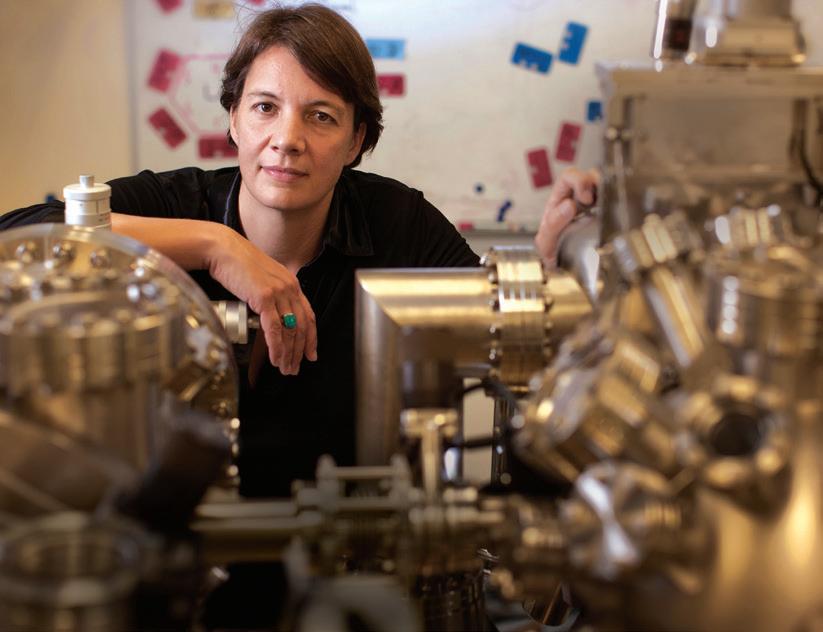
“Centres of Excellence are one of the main vehicles to enable high-quality research in Australia,” Shrapnel says.
“They’re well-funded, multi-node centres creating networks of expertise that can interface with government, industry and community.”
Bachor says in the early days the centres played an important role in giving researchers the time needed to build a successful endeavour.
“The first generation of Centres of Excellence lasted about seven or eight years, which was long enough to get us an international reputation, to attract people, and to form collaborations with Europe and the USA. So the whole thing flourished.”
Australia has now produced more than 2,500 PhDs in quantum technology research and development in 30 years, and several major quantum tech companies have spun out of this research. But the greatest strength to emerge is one of continuous innovation in physics.
“The technologies are now at the stage where they’re attracting big money – but that doesn’t negate the ongoing importance of the university sector,” Shrapnel says. “The potential for quantum technologies relies on every step in the chain, so we’ve still got to keep doing quality foundational work, including ongoing investment in students studying pure maths and pure physics.”
Bachor says universities remain a critical part of maximising quantum promise.
“While money, technology and access to equipment are all important for getting the most from quantum, having access to the right people is crucial. Companies need scientists who have a PhD – the training you get at a university is the essential process.”
And while quantum delivers on the promise of decades of exploratory research, the depth of the innovation in this area is just beginning to bear fruit.
“Australia offers a culture of academic freedom, openness to ideas, and an amazing willingness to pursue goals that are ambitious,” says pioneering quantum researcher Professor Michelle Simmons. By developing the capacity of new generations to engage in revolutionary research like this, Australia has placed itself “several years ahead” of the US in the race to build a quantum computer.
— Sarah KeenihanIn April 2022, the International Panel on Climate Change detailed actions to halve global carbon emissions by 2030. The calculations relied on improved cost-effectiveness of energy capture through solar panels.
“Ten years ago, that sort of maths would not have been possible,” says Martin Green, Scientia Professor at University of New South Wales (UNSW) and Founding Director of the Australian Centre for Advanced Photovoltaics.

Green says university science is the reason solar cells are now the most cost-effective option for low-carbon electricity generation, and his research group held multiple records for the most efficient solar cell between 1983 and 2023.
The main factor that ensured this new technology had global impact was the university training UNSW students received in the early days of PERC’s development.
“UNSW scientists went on to become key figures in establishing and developing the global solar cell industry,” he says. “They have transformed the solar industry by using their expertise to establish manufacturing in low-cost regions of Asia.”
PERC technology has been the most commercially viable silicon solar cell technology used in large-scale electricity production, and accounted for almost 90% of the global solar cell market in 2022.
 Pioneering quantum researcher Michelle Simmons, scientia professor of quantum physics at the University of New South Wales
Pioneering quantum researcher Michelle Simmons, scientia professor of quantum physics at the University of New South Wales
“THE TECHNOLOGIES ARE NOW AT THE STAGE WHERE THEY’RE ATTRACTING BIG MONEY –BUT THAT DOESN’T NEGATE THE ONGOING IMPORTANCE OF THE UNIVERSITY SECTOR.”
Science, at its core, is more than a collection of theories, experiments and discoveries. It’s the human spirit — a dynamic blend of knowledge, individual enquiry and human connections — that powers our understanding of the world and beyond. Nowhere is this more evident than in the labs and lecture halls of our universities.

“To me, the soul of science is about fostering curiosity and empowering communities. It’s about generating knowledge, not adhering to rigid frameworks,” says Associate Professor Parwinder Kaur, a molecular biologist at the University of Western Australia (UWA) and also the Director of DNA Zoo Australia.
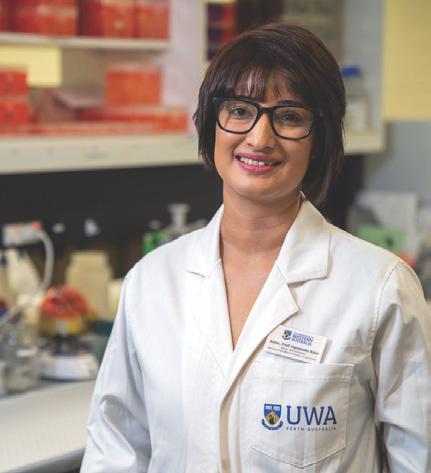
Kaur’s background is a powerful illustration of how human experiences and stories form the fabric of science. Her passion for science was sparked as a child in India, when she observed how biotechnology helped her uncle fight agricultural pests and diseases. However, upon graduating from Punjab Agricultural University, she found herself at risk of being ‘boxed into’ her burgeoning specialisation and unable to follow the natural evolution of her curiosity into further research. This led Kaur to Australia’s university ecosystem, where she was able to pursue a PhD in plant pathology at UWA.
“I came here, I was nurtured, I was able to do some amazing work,” she says.
Since then, Kaur’s career journey has been testament to the impact of science that is responsive, collaborative and curiosity driven. Her PhD evolved into postdoc research in plant genetics, including co-authoring the world’s first complete genome sequence of the subterranean clover – a key annual Australian pasture legume. A collaboration with genomics experts at Baylor College of Medicine, in Houston, Texas, which stemmed from that study, then laid the
groundwork for DNA Zoo — an ambitious global initiative to create a library of complete DNA maps for threatened plant and animal species. UWA is a leader among the over 120 collaborating partners, across nine countries, that compose the ‘zoo’. “It is one of the most collaborative consortiums I have ever had the pleasure of working with,” Kaur says.
Kaur was in Houston, at the founding lab of DNA Zoo, when the pandemic broke out, presenting another opportunity to adapt knowledge across disciplines. Researchers at DNA Zoo redirected their focus and applied their expertise to develop a DNA test for the new virus. “This was a new problem that we had the tools to address. We had capacity in the lab, it was just looking at the same thing from a different perspective and asking a different question,” Kaur explains.
“Collaboration is key,” she adds. “You don’t need to know everything, just the right people, who can support you when tackling big questions.”
Universities nurture science by creating environments conducive to natural enquiry, environments that embrace exploration and the power of learning from mistakes.
“The great thing about universities is that you are free to explore your imagination and attack things that you find of interest,” says Professor James Whisstock, an ARC Laureate Fellow and Senior Principal Research Fellow at the National Health and Medical Research Council at Monash University’s Biomedicine Discovery Institute.
Whisstock celebrates universities as incubators of the human connections – whether serendipitous encounters or strategic partnerships — that so often spark scientific ideas and innovation.

“Universities create an environment where people are thrown together, and that’s where ideas grow,” he says.
When Whisstock’s lab discovered that our immune system’s “killing machines” were closely related to bacterial toxins — a finding that bridged two distinct scientific disciplines and informed both fields — it highlighted the power of crossdisciplinary collaboration within a university environment. “Suddenly, there’s this wealth of information from another field that became relevant to ours,” he says. “Biology is an enormous network. The problem is, we don’t know most of the connections. When you’re able to make those connections, the multiplier effect is enormous.”
Biology isn’t the only field that benefits from the power of multidisciplinary co-operation. For instance, Professor Maria Forsyth, a renowned energy storage and corrosion science expert at Deakin University, notes the complex field of energy transition as an area where collaboration is vital. “We’re only going to make the transition by encouraging change in thinking and community awareness,” she says.

In one project, Forsyth brought together chemistry PhD students and law students to develop ethical and regulatory frameworks for a battery recycling program. “They were teaching law students about battery chemistry, and we were learning from the law students about the legal and social aspects,” she says.
It’s clear universities are more than academic institutions; they are vibrant ecosystems that accommodate scientists who come from a range of backgrounds and are often seeking academia’s unique environment.
“Universities provide a safe space for extraordinary people who change the world in surprising ways,” Whisstock says.
Forsyth embodies this. As a noted mentor in her field, she has supported the careers of hundreds of young scientists — many of whom have gone on to become research partners — and she was recently named a finalist for the 2023 Eureka Prize for Outstanding Mentor of Early Researchers.
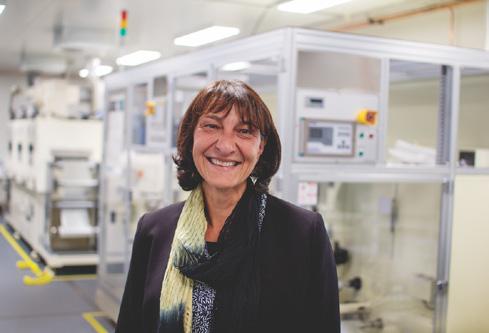
Creating a culture that recognises the
importance of failure and exploration on the path to progress is critical, Forsyth says. “Sometimes, what fails leads to the next innovation. It’s about building knowledge and seeing that as success.”

For instance, in her domain of energy storage science, she notes that progress isn’t always about a breakthrough. “Everyone’s waiting for the big breakthrough in battery technology, and of course we want that too, but that’s not what science is about,” she says. “Ultimately, every little piece of science that we do is building on a foundation of knowledge.”
In the future, Kaur says, we need to acknowledge a shift from a prestigedriven model to a knowledge-driven one. “Universities should be places for following curiosity, not chasing prestige. I never signed up for a race towards H-index,” she says, referring to the popular measure of a scientist’s research output.

Forsyth echoes this sentiment, cautioning that the race for publication in ‘high-impact’ journals can dampen curiosity and innovative thinking. She also champions smaller research groups as more conducive to nurturing scientists, saying, “I would encourage both younger researchers and leaders to work closely with a small, engaged group to find excitement in their work, instead of
spreading themselves too thin.”
The heart of scientific progress remains steadfast: the people. They’re the ones whose curiosity leads them down untrodden paths, the collaborators who understand that the most complex problems require diverse minds, and the risk-takers who aren’t afraid of failure because they know it often precedes groundbreaking discovery.
Despite the headwinds Kaur faced from disciplinary silos early in her career, she is living proof of the power of the individual to challenge the status quo, and she is positive about how universities can help nurture this human spirit of science.
“It has been an absolute privilege to be part of the workforce in the university sector, as you get to break new grounds towards knowledge creation and translate existing knowledge into real-world applications working with the best and brightest, while also inspiring the next generation,” she says. — Gemma
ChiltonIt takes the whole faculty to foster exceptional science.
1. Universities develop the capacity of new generations to engage in it. The next generation of graduates are the ones who will push the boundaries of science in Australia. It’s a cohort whose numbers rose to a seven-year high of 47,000 in 2021, the STEM equity monitor shows, while a report from Victoria University found the cumulative total of PhDs in Australia touched 185,000 in 2021.
These graduates and postdocs have already made their mark on the world. Industry internships from the Australian Mathematical Sciences Institute (AMSI) allow the likes of University of Wollongong’s Carrie Wilkinson to better understand how regional properties face bushfire threats in a changing climate, as part of research done in partnership with the NSW Government. Grads like Carrie form part of the 141 ARC Discovery Early Career Research Awards for STEM projects in 2022. This culture of innovation develops by actively throwing together students with academic and industry mentors, who can provide insight into how new ideas fit into their chosen field.
Without the exploratory nature of science, whole industries wouldn’t exist. For example, electromagnetic theory led to X-rays and Albert Einstein’s description of the photoelectric effect was the basis for quantum theory — and lasers. Today, human genome mapping and molecular biology have completely changed how we understand disease and agriculture. Academics also engage with citizen scientists on projects, such as the RMIT-UNSW urban microclimate
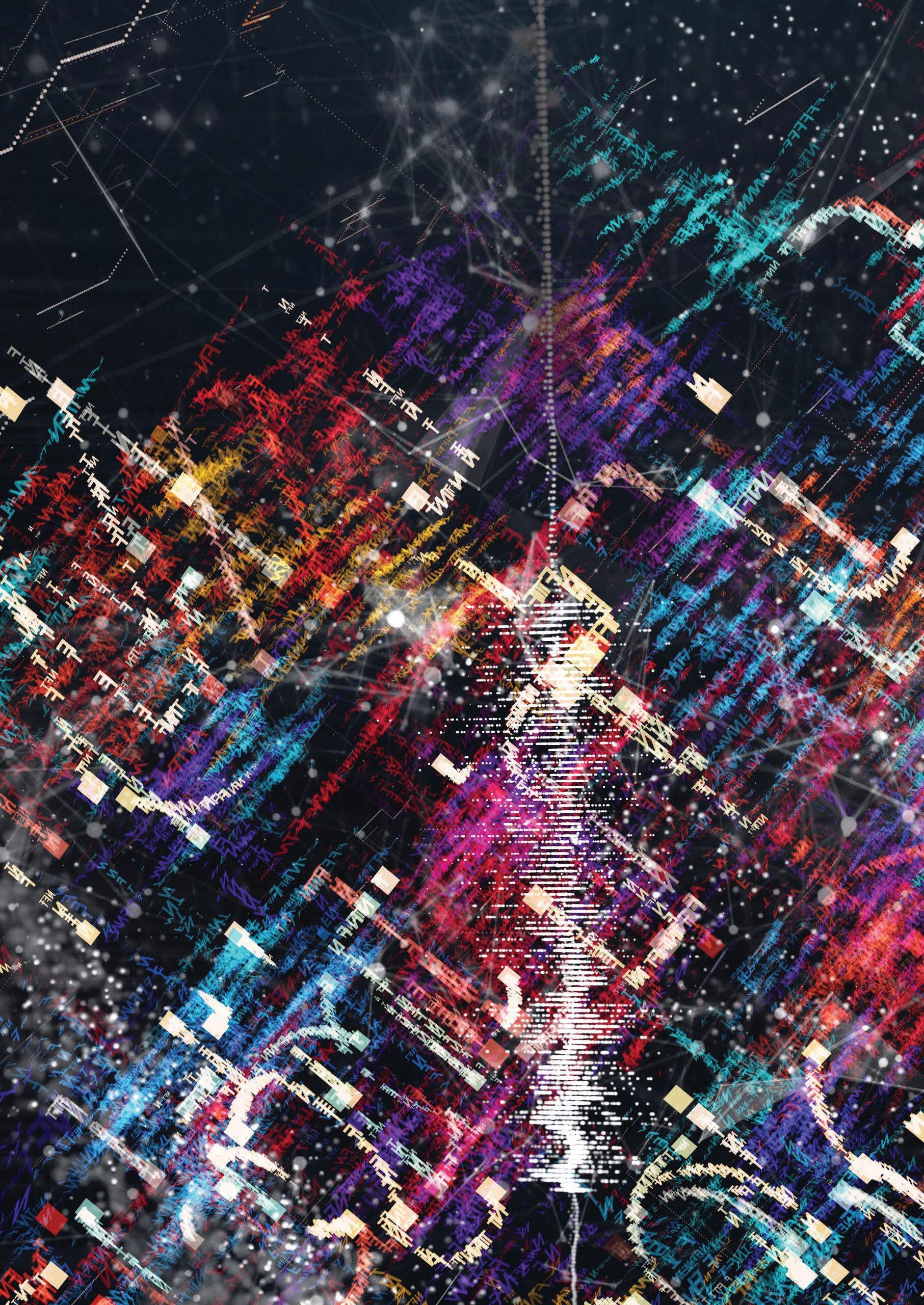
project in 2018-19. The Threatened Species Recovery Hub, between 2014 and 2021, was a collaboration between people from the Larrakia Nation around Darwin and dozens of scientists from universities around Australia. These partnerships are the result of decades of work by universities to create open communication and networks, so scientists can share their own expertise with businesses and communities located in Australia.
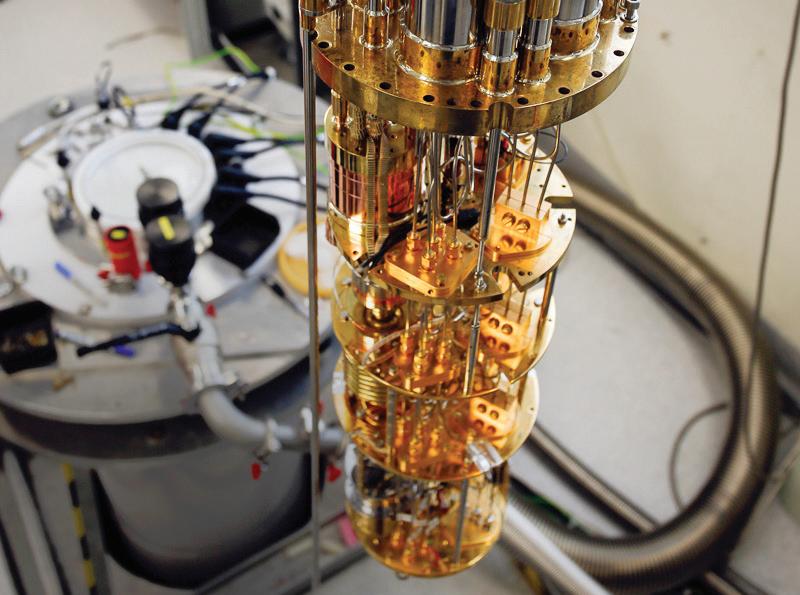
Australian universities are the primordial soup where commercialised IP based on science is cultured, but they’re also the stewards of the science whose effects might not be felt — not immediately, at least. For example, university researchers have been pushing quantum science forward since the 1980s but it was only in 2017 that UNSW was able to turn some of that knowledge into Australia’s first quantum computing company, Silicon Quantum Computing. Universities support those early ideas with equipment,
laboratories, telescopes, microscopes, mass spectrometers, biological containment facilities, clean rooms and funding. But these institutions also hold channels open, allowing those ideas to be used to solve problems communities face, such as in environmental science or industry.
Serendipity plays a part in scientific breakthroughs; for example, 2011 Science Minister’s Prize for Life Scientist of the Year winner Min Chen wasn’t looking for a new kind of chlorophyll when she found it. But it came after years of hard work and collaborations with others. Universities’ role as junctions where ideas are exchanged and explored, and scientists network with others nationally and internationally, creates the opportunity for seemingly serendipitous moments to happen more regularly. It is as important as providing the microscopes and labs also needed to make breakthroughs happen.
— Rachel Williamson